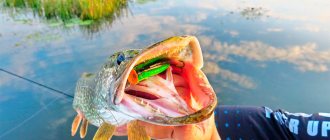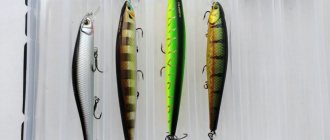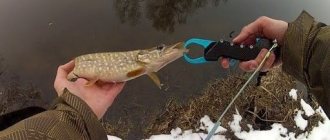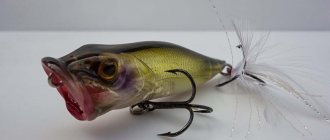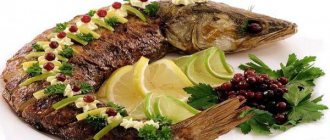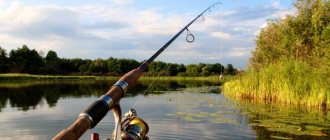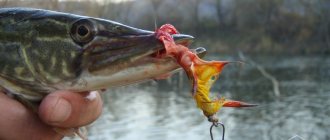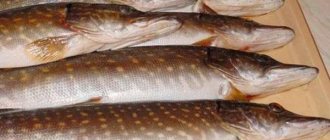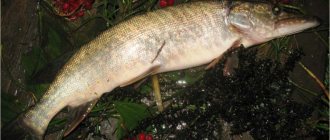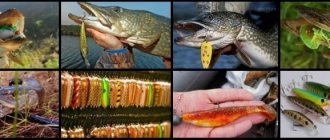A popper is a surface wobbler used for fishing in shallow water bodies or in shallow water.
Poppers do not have a blade, but have a special recess in the front part; in some models the front part is straight. This recess serves to create special squelching and gurgling sounds and the accompanying squelching splashes, similar to those that occur when a small fish jumps out of the water. These sounds and splashes are very attractive to predatory fish, and they attack the bait moving along the surface of the reservoir.
In addition to their special shape, some models contain balls inside, which create noise effects during wiring.
The length of the bait can vary from 4 to 15 cm. The popper has two tees. One is attached in the middle to the ring, and the second to the tail section. A fringe is often attached there to attract a predator during posting.
Poppers are made from balsa, plastic or foam. The color of baits can be very diverse: from natural to bright acid colors.
Where is the best place to fish with popper?
First of all, you need to clearly understand that not all bodies of water are suitable for popper fishing.
Large open deep lakes and fast rivers disappear immediately. Ideal places for popper fishing are shallow bodies of water, covered with aquatic vegetation, with no or very little current, and especially estuaries. There is always a predator in ambush here, whose usual prey is fish fry feeding in the same grass.
The best areas for fishing are considered to be areas 1.5-2 m wide near water lilies, reeds and coastal vegetation. In such places you can most likely catch pike, perch, chub and, much less often, pike perch.
Features of the bait
Popper is a hard bladeless bait specially designed for catching fish feeding in the upper horizon. It looks like a wobbler, but instead of a blade, it has a notch in the nose. With its help, this topwater creates splashes and makes a sound, which attracts the attention of a predator.
For reference! It is difficult to say unequivocally why popper attracts pike. But the fact that she likes such fuss is an indisputable fact.
Poppers for pike are a bait with a length of 7 to 9 cm. Smaller models also catch toothy beasts, but they are considered perch baits and catch mainly small “pencils”. Based on buoyancy, there are two types of topwaters:
- floating (F – floating);
- sinking (S – sinking).
Sinking poppers are considered search baits. They have better flight characteristics and require faster guidance in order to remain in the surface horizon.
A high-quality popper works stably, without failures.
Floating poppers are the basic option for catching pike. They allow different wiring, allowing you to seduce even a passive predator. They can be used to perform long pauses, “stomping” in place, slow monotonous feeds and other animation techniques.
When is the best time to fish with a popper?
The best time of year for popper fishing is summer, from June to mid-September, when frogs are active on the pond, and small fish often swim near the surface of the water. As soon as the water temperature drops, the efficiency of the popper drops sharply.
During the day, the best bite is undoubtedly at sunset. Zhor begins an hour and a half before sunset and continues until complete darkness. In the morning, the bite begins at sunrise, as soon as the fry enters open water, and lasts for three hours, and then stops.
Fishing during the feeding season, especially in the evening, resembles a crazy race, when on every cast you see a predator coming out and a bite, and you just have to correctly determine the moment of hooking.
The best weather for popper fishing is if there is either complete calm on the reservoir or a slight breeze that only raises small ripples. When fishing with a popper, a little drizzling rain will not hurt when the fish also comes to the surface. The gurgling sound of a popper in the quiet morning and evening hours can be heard over a long distance and attracts predators. If the wind drives the wave, the popper becomes useless; wobblers with minimal depth come to the rescue. In addition, in strong winds, a light popper is very difficult to cast. In cloudy summer weather, the bite can last all day. There is no point in catching a predator in the heat in shallow water. It is better to find a shady area among trees and bushes.
What is a popper
A popper is a type of wobbler, a funnel in the front part . During the wiring, it throws water forward over and over again, making gurgling sounds. Such baits, as a rule, are equipped with two tees ; an edge may be located in the rear part .
Poppers first appeared on sale in the 1930s. They were produced by an American company that specialized in the manufacture of surface baits. During the retrieve, the popper resembles a sick, weakened fish, a toad , or a large insect that has fallen into the water and splashes at the surface.
There are two types of these baits depending on the geometry - so-called pencils and cone poppers . The former have an elongated cylindrical , the latter are expanded in the front part.
Pencil poppers make weak splashes when retrieved, but at the same time they are actively thrown from side to side. Cone baits, in turn, make loud gurgling noises and move along a relatively flat trajectory.
Popper fishing tackle
Popper fishing gear is not much different from a classic spinning rod, but there are still features that help improve fishing efficiency.
For popper fishing you need a short, light, stiff carbon fiber rod with a fast action. The faster the action, the better the popper's reaction to step-by-step wiring and the harder the hook.
- construction is fast;
- optimal length 1.8-2.4 meters;
- spinning test up to 20 grams.
The reel should be small and light, with a small spool and a fairly large gear ratio, which allows you to save a lot of time when recasting gear and quickly remove the bait from the water during idle bites.
- the optimal reel size for popper fishing is from 2000 to 3000;
- coil gear ratio is at least 5:1;
- An instant stopper is required;
- The reel must have good line lay.
It is best to use a dark-colored braided line with a tensile strength of 7-8 kg. At the end of the fishing line, a thin stranded steel or tungsten metal leash 25-30 cm long is placed, as well as a swivel with a clasp. When using larger poppers, the line and leader are set a little thicker.
If you fish in reservoirs where there are no pike, then the popper is tied directly to the fishing line.
Fishing technique and tactics
Fishing with a popper is very different from fishing with a regular wobbler. In order for fishing to bring pleasure and a big catch, you need to know how fishing is done, as well as in which bodies of water and at what time it is better to fish.
Wiring Features
The main difference between fishing with a popper is that the tip of the spinning rod must be kept as close to the water as possible. This will significantly improve the stability of the game. The wiring itself is carried out in approximately the same way as on a conventional wobbler. The most standard game is the uniform retrieve, in which the popper moves at a constant speed. You can decorate the wiring a little, add short and long pauses, speed up and slow down a little. Such techniques will allow you to stir up a sleeping predator. When fishing with a popper, you need to make sure that it does not fly out of the water. Perch is also caught well with wobblers. If this happens, you need to reduce the jerking force or the wiring speed.
How to fish with a popper?
You can fish with a popper from the shore, wade, and from a boat. However, it is most convenient to fish from a boat, since it can reach the most overgrown places. The technique of fishing with a popper is extremely simple. The main condition is maintaining silence. This is especially true for fishing from a boat.
This is the most commonly used tactic. Cast the popper as close to the aquatic vegetation as possible. After casting, remove the slack in the line and lead the bait with short (20-30 cm) jerks of the rod along the surface of the water, quickly reeling in the line after each jerk so that the popper freezes for no more than 1-2 seconds.
The main task is to achieve such a jerk that the popper makes a characteristic gurgling sound, for which it got its name. Each type of popper may vary slightly in force and amplitude, but the step principle should remain the same.
There are three options for popper wiring:
1) Classic wiring is when the reel handle is rotated at medium speed without pauses. You can do small jerks with small amplitude. The speed of posting depends on many factors. First of all, it depends on the activity of the fish, as well as on the model of the popper itself. As the popper approaches the shore, you should lower the rod tip towards the water. It turns out that the popper will attract the predator throughout the entire wiring. Sometimes it happens that a pike or perch simply chases a popper to the boat or to the shore. In general, the universal movement of the popper, when it moves at the same speed, attracts active fish.
2) Slow wiring. It is characterized by a large number of pauses and stops. Typically this type of popper wiring is used when the predator is passive.
3) Chaotic wiring. Sometimes this type of popper wiring helps if other methods have failed. The essence of this wiring is that the popper is carried out with sharp jerks, followed by a pause of several seconds.
As for jerking, it is very important to jerk with the right force; it is useful to change the frequency of jerks, the length of pauses, and adapt to the mood of the fish. The more active the fish, the more aggressive the retrieve should be, and vice versa, if the fish is not active, it is better to move the bait slowly and try to pause.
Anglers define a bite visually as the fish emerging or throwing from under the water. It grabs the bait and turns into the depths, as a result of which a characteristic breaker and whirlpool appear in place of the popper, the strength of which depends on the size of the predator and its activity.
Often the predator misses and flies out of the water in the place where the popper had just been, makes a “candle” and falls back into the water. Therefore, after an unsuccessful attack or a blank hook, you need to quickly pull out the bait and quickly throw it back to the same place. Very often, attacks occur on every cast until the prey is caught. It happens that only the fourth or fifth cast ends in a catch.
Posting a popper for pike
Pike prefers two types of wiring:
- With a pause. Wiring involves short jerks with pauses of 1-2 seconds. At the same time, the popper makes a short gurgling sound, as if feeding.
- With imitation. Based on imitation of a fish escaping from a predator. Achieved by several simultaneous jerks and reeling of the fishing line.
It is recommended to alternate both options so that the predator does not notice the catch. In between, you can use slow wiring.
Which popper is the most catchy?
Classic Rapala poppers catch fish great!
Popper can be a very catchy bait in certain conditions. Today on the market there are baits from different companies, for every taste. The fisherman has a wide choice, the opportunity to experiment in different bodies of water and in different fishing conditions.
A huge advantage of floating poppers is that they are very difficult to lose. Even if you get caught on a reed or a protruding fallen tree, you can get the bait by swimming to it in a boat.
It is quite easy to check the effectiveness of a popper and its suitability for a given reservoir. First of all, you need to determine which juvenile fish make up the food supply of the predator in the reservoir. If it is a rudd, then the popper should have a golden tint and red fins; if it is a roach, then a silver-gray color without bright fins is suitable; if it's a perch, then striped patterns, etc. will work. The more the popper resembles the fish living in this reservoir, the higher the chances of success. There is also an opinion that a popper attracts pike not by its appearance, but by the sound and splashes it makes, so the color of the bait is not so important.
As for my personal preferences, the result of numerous experiments was the choice of classic poppers from Rapala , namely Skitter Pop 5-9 cm in size, painted to look like roach. This popper is the most catchy under a wide variety of fishing conditions. In waters with a lot of smallmouth bass, cross-bar poppers work better than silver ones.
Catch Poppers:
- Rapala Skitter Pop;
- Heddon Pop`n Image;
- Rebel Pop-R;
- Megabass Pop – X;
- Daiwa TD Popper Zero;
- Yo-Zuri 3D Popper;
- Yo-Zuri Eba Popper;
- Owner Gobo Popper;
- Strike Pop;
- Salmo Pop.
Fishing with a popper is very interesting - the bait moves along the surface while fishing, and all attacks are clearly visible. This type of fishing is a lot of fun.
Poppers
One of the first baits for surface fishing that I, and many of my colleagues, became familiar with was the popper. An unusual deception. It looks like an elongated minnow class wobbler. Volumetric body. The arrangement of tees is traditional for wobblers. The difference was the absence of a blade at the front. Instead, there is an angled cut of the end and a recess in the bow.
After casting, the popper lies quietly on the surface. If you just start to lead it evenly, then most models will not show any game at all. Here you need a jerky retrieve: fairly short rhythmic twitches with the tip of the spinning rod. After a little practice in shallow water, they select their own feeding pattern for each specific model. As a result, the popper, with its nose notch, raises a wave and forms a bubble. The bubble bursts, creating a breaker, splashes and a characteristic sound. Apparently this sound was perceived by the creators as “pop” and became the basis for the name.
The popper carried out in this way attracts the attention of the fish and provokes a bite. This is how they catch perches when they chase the fry with a champing sound. In the famous “perch pots” the popper is one of the best baits. Pike can also be caught with it when standing in the grass, in shallow water. The good thing about a popper is that it allows you to sweep across the surface without picking up algae. Even if the layer of clean water is only 10 cm, and then there is a carpet of dense plexus of algae, the fish will bite. Any other, non-special surface bait will immediately catch on here and we will scare away the fish.
The asp is also not averse to attacking the popper. Since the fish is cautious, the bait must be cast far, using models of long-range poppers equipped with a special long-distance casting system. Or provide bait from an ambush.
Chub, when hunting in the upper layer, also fall for poppers. But you need to use small models, up to 5-6 cm long. For all of the above predators, larger baits are relevant. In the area from 7-8 cm to 10-12 cm.
Special mention should be made of the colors of poppers and other surface baits. The fish looks from below. For her, all objects on the surface look like black silhouettes against a white sky. So, there is no point in choosing a popper color that is attractive to fish. The only exception is the asp. A keen-sighted fish that lives in clear waters. For it, it is better to choose natural colors, silver, for bleaching. In all other situations, the color of the blende is chosen for the fisherman. Surface baits, like no other, need visual control of their game and trajectory of movement. So, bright, dark, contrasting colors are what you need. They allow the angler to clearly see the bait even at a great distance.
How to catch pike in the spring with a popper?!
Everyone knows that when the ice melts on reservoirs, pike rush to shallow water. Near the shore, the water is warmer and, accordingly, a large number of fish tend to go there in order to accumulate strength before spawning; pike is no exception.
Therefore, the popper can be carried out along the coastal shallows. There is no algae yet, so the likelihood of snags is not high, however, the likelihood of a toothy attack is quite high. Since in shallow water a popper will be an easy catch for her.
